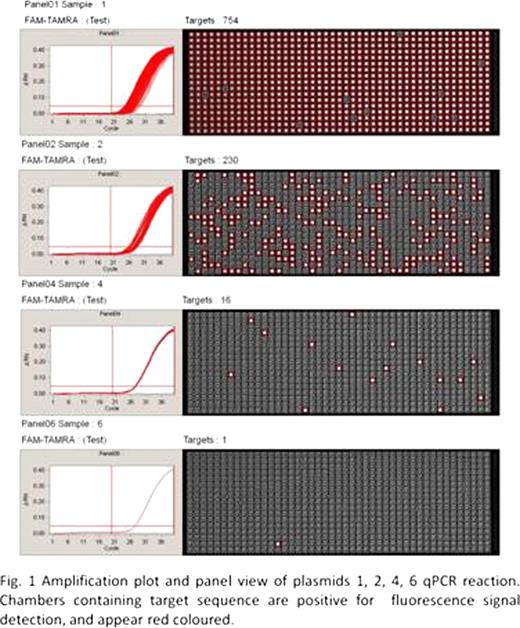Abstract
Abstract 1677
The BCR-ABL1 positive ALL is the most frequent and prognostically most unfavorable subtype of ALL in adults. Treatment strategies based on tyrosine kinase inhibitors of first and second generation have improved overall treatment results, with a rapid and complete remission (CR) rate ranging 90%. Nevertheless most patients experienced hematological relapse in a short time, also after hematopoietic stem cell transplantation. Therefore, the detection of residual leukemic cells by measuring BCR-ABL1 transcript level is absolutely required to monitor minimal residual disease and to detect early relapse. Different assays based on quantitative polymerase chain reaction (qPCR) are available and they vary in respect to the type of instrument used, the primer and probe location, the real-time chemistry and the control gene used. Differences among methods can lead to a variation in the sensitivity and measurement reliability. In order, to investigate the efficacy of a high sensitive method based on nanofluidic platform (Fluidigm Corporation, South San Francisco, CA) to detect and quantify residual and rare BCR-ABL1 copies, we compared the molecular results obtained by conventional qPCR with those obtained by nanofluidic Fluidigm approach. At the time of writing, 60 BCR-ABL1-positive ALL samples (42 positive for the p190 BCR-ABL1 isoform and 18 for the p210) were analyzed. First, we performed a TaqMan absolute quantitative PCR (Applied Biosystems 7900HT Fast Real-Time PCR System); RNA integrity was evaluated using the control gene ABL1. Both BCR-ABL1 or ABL1 copy number copies were derived by the interpolation of cycle threshold (Ct) values to the appropriate standard curve obtained using different plasmid dilutions (Ipsogen), each containing known BCR-ABL1 or ABL1 gene copies. Samples resulted in complete (38.3%) or major (61.7%) molecular response (BCR-ABL1/ABL1 ratio ≤ 0.001 or < 0.1, respectively and according to the International Scale). Subsequently, we quantified again the samples using the 12.765 Digital array (Fluidigm). This is a nanofluidic biochip that consists in twelve panels, each containing 765 individual reaction chambers of 6 nL volume. Samples are portioned prior to qPCR into the single chambers of the panel; as fluorescent signal is produced only in chambers containing copies of the target sequence, digital array provides an absolute quantification by counting the number of positive reactions. Following amplification, digital raw data are processed by the BioMark Digital PCR Analysis software (Fluidigm), that estimates the true number of molecules per chamber using the Poisson probabilistic distribution. First, we assessed the sensitivity and reproducibility of the assay using six serial dilutions of plasmids (Ipsogen) expressing known copy number of BCR-ABL1 p190 transcript (10000; 1000; 100; 50; 10; 1 copies). A 2 μl volume of input leukemia cDNA was loaded and two panels for each dilution were used. Analysis parameters chosen for digital raw data processing were automated set threshold and target Ct range 20–40. Results showed a detection rate until a copy of target sequence (Fig. 1) and a pairing significantly effective between replicates. We then analyzed duplicates of BCR-ABL1 positive ALL samples with a positive control for each chip: digital array resulted positive in 22 major molecular response samples (59.46%; 3.25 median number of copies detected, range 0.5–33.5), and in 1 complete molecular response sample (4.34%). Moreover, the comparison between TaqMan and Fluidigm methods resulted in the detection of the same BCR-ABL1 copies in 53.34% (group I); in 35.0% the quantity detected by Fluidigm was lower than that detected by TaqMan (group II); finally, in 11.66% the Fluidigm approach resulted more sensitive than TaqMan (group III). In conclusion, we demonstrated that the Fluidigm nanofluidic platform provides a high sensitive assay, able to detect until a single copy of BCR-ABL1 transcript, as demonstrated with plasmid serial dilution detection rate and with samples in molecular remission and it could provide an accurate monitoring method for BCR-ABL1-positive ALL CR patients. Supported by: European LeukemiaNet, AIL, AIRC, Fondazione Del Monte di Bologna e Ravenna, FIRB 2006, PRIN 2008, Ateneo RFO grants, Project of integreted program (PIO), Programma di Ricerca Regione – Università 2007 – 2009.
Baccarani:NOVARTIS: Honoraria; BRISTOL MYERS SQUIBB: Honoraria. Martinelli:Novartis: Consultancy, Honoraria; BMS: Honoraria; Pfizer: Consultancy.
Author notes
Asterisk with author names denotes non-ASH members.


